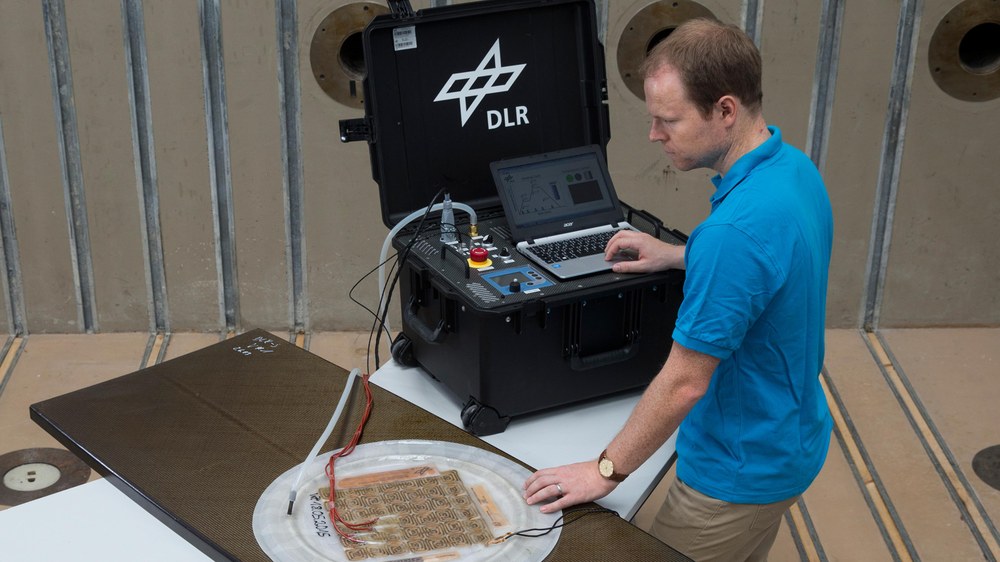Patches for high-performance structures – DLR researchers develop new repair process for fibre-reinforced polymers
Aircraft and vehicle manufacturing are becoming increasingly dependent on structures made of fibre-reinforced polymers (FRPs). The reason for this is the advantageous properties of these high-performance composites – they exhibit high stiffness and strength, but are low in weight. The proportion of FRPs in the new Airbus A350 is already more than 50 percent, and with the BMW i3 electric car, the material has made its way into automotive series production as well. Researchers at the DLR site Stuttgart have developed a new repair concept to make fibre-reinforced polymers more competitive, cost-effective and resource-efficient. The aim of the DLR scientists is to avoid the premature disposal of FRP components and to minimise waste during production – of great importance because the manufacturing of FRP structures still involves a great deal of manual labour.
Using a laser, induction and a vacuum on damaged areas
"As the production of FRP components is complex, and therefore costly, repair processes have generally been time-intensive, inflexible and expensive. Large structures – such as those in an aircraft fuselage – are designed for a service life of up to 30 years. In the event of damage, they usually have to be removed for repair or completely replaced," says Project Leader Markus Kaden from the DLR Institute of Structures and Design, explaining the significance of suitable repair concepts.
With metal structures, the damaged area is cut out and new metal riveted in. Components made of fibre-reinforced polymers entail a more complex repair process. "As the fibres are load-bearing and are responsible for the cohesion and resilience of the structure, we cannot simply drill and rivet here; that would only damage the fibres even more," says Kaden, explaining the core difference in repairing FRPs as compared to metallic materials. Instead, the DLR researchers remove the damaged layers of the material and replace them with a patch similar to a sticking plaster. The patch is made of the same material, has the same fibre alignment and is bonded to the surrounding structure using the effects of heat and pressure.
The repair process used by DLR here has two special features: "Firstly, we remove the damaged material using a laser. Unlike other methods, in which the material is removed with a milling cutter, for example, our process does not require any cooling, there are no clamping or pressure forces on the structure and the tool wear is very limited," says Kaden of the first benefit of the DLR process. "Secondly, we only heat the area of the patch and the damaged area of the structure. We do so using a metal sheet heated by induction that is the same size as the patch and is pressed onto the patch by creating a vacuum. The patch is then bonded with the surrounding structure under pressure and at a high temperature."
The new repair method offers more flexibility than previous technologies. By using ovens or autoclaves, the entire component is heated. Heating blankets, infrared lights or heated air systems offer the possibility of heating only parts of the structure, but are not specifically targeted to the specific area to be repaired. At the same time, DLR uses an additional insulation layer to achieve temperatures of over 300 degrees Celsius, which means that even special fibre-reinforced composites called thermoplastics can be repaired.
Award-winning mobile repair station
With the support of DLR Technology Marketing, the researchers in Stuttgart have developed a mobile repair station that can be used to demonstrate the process. It includes all the systems required for repairing FRP structures. In addition to the equipment for inductive heating of the metal sheet, it has a vacuum pump for generating the required pressure on the patch. The individual processes can be controlled via a netbook using temperature sensors.
Currently, 'bonding' is not yet approved in the aviation sector for repairing load-bearing structural components made of high-performance composites. Nevertheless, Kaden is optimistic: "There are currently many new developments in this area. Several companies have already shown interest in our repair concept and in developing it further for industrial use." Furthermore, at the JEC Americas Composites Show & Conferences in Houston (USA), DLR's repair concept was awarded the JEC Award in the MRO (Maintenance, Repair and Overhaul) category. The award recognises the best innovations in the fibre composites sector.

